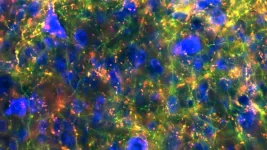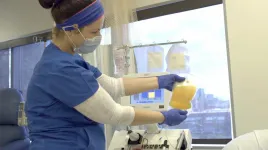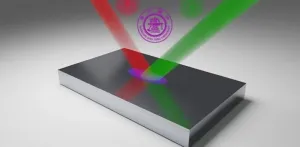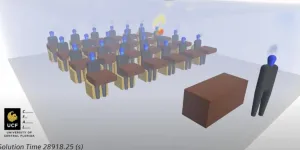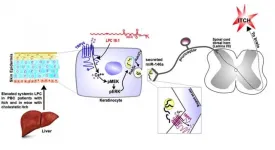(Press-News.org) Thousands of our daily activities, from making coffee to taking a walk to saying hello to a neighbor, are made possible through an ancient collection of brain structures tucked away near the center of the cranium.
The cluster of neurons known as the basal ganglia is a central hub for regulating a vast array of routine motor and behavior functions. But when signaling in the basal ganglia is weakened or broken, debilitating movement and psychiatric disorders can emerge, including Parkinson's disease, Tourette's syndrome, attention deficit hyperactivity disorder (ADHD) and obsessive-compulsive disorder.
Despite its central importance in controlling behavior, the specific, detailed paths across which information flows from the basal ganglia to other brain regions have remained poorly charted. Now, researchers at the University of California San Diego, Columbia University's Zuckerman Institute and their colleagues have generated a precise map of brain connectivity from the largest output nucleus of the basal ganglia, an area known as the substantia nigra pars reticulata, or SNr. The findings offer a blueprint of the area's architecture that revealed new details and a surprising level of influence connected to the basal ganglia.
The results, spearheaded by Assistant Project Scientist Lauren McElvain and carried out in the Neurophysics Laboratory of Professor David Kleinfeld at UC San Diego, and the laboratory of Zuckerman Institute Principal Investigator Rui Costa, are published April 5 in the journal Neuron.
The research establishes a new understanding of the position of the basal ganglia in the hierarchy of the motor system. According to the researchers, the newly identified pathways emerging from the connectivity map could potentially open additional avenues for intervention of Parkinson's disease and other disorders tied to the basal ganglia.
"With the detailed circuit map in hand, we can now plan studies to identify the specific information conveyed by each pathway, how this information impacts downstream neurons to control movement and how dysfunction in each output pathway leads to the diverse symptoms of basal ganglia diseases," said McElvain.
With support from the NIH's Brain Research through Advancing Innovative Neurotechnologies® (BRAIN) Initiative, the researchers developed the new blueprint working in mice by applying a modern neuroscience toolset that combines techniques from genetics, virus tracing, automated microscopic imaging of whole-brain anatomy and image processing. The results revealed surprising new insights about the breadth of connections.
"These results are an example of how researchers supported by the BRAIN Initiative are using the latest brain mapping tools to change in a fundamental way our understanding of how the connections in the brain's circuits are organized," said John J. Ngai, director of the NIH's BRAIN Initiative.
Previous work had emphasized that the basal ganglia architecture is dominated by a closed-loop with output projections connecting back to input structures. The new study reveals the SNr broadcasts even to lower levels of the motor and behavior system. This includes a large set of brainstem regions with direct connections to the spinal cord and motor nuclei that control muscles via a small number of intervening connections.
"The new findings led by Dr. McElvain offer an important lesson in motor control," said Kleinfeld, a professor in the Division of Biological Sciences (Section of Neurobiology) and Division of Physical Sciences (Department of Physics). "The brain does not control movement though a hierarchy of commands, like the 'neural networks' of self-driving cars, but through a scheme of middle management that directs motor output while informing the executive planners."
Remarkably, according to the researchers, the SNr neurons that project to the low levels of the motor system have branched axons that simultaneously project back up to the brain regions responsible for higher-order control and learning. In this way, the newly described connectivity of SNr neurons fundamentally links operations across high and low levels of the brain.
"The fact that specific basal ganglia output neurons project to specific downstream brain nuclei but also broadcast this information to higher motor centers has implications for how the brain chooses which movements to do in a particular context, and also for how it learns about which actions to do in the future," said Costa, a professor of neuroscience and neurology at Columbia's Vagelos College of Physicians and Surgeons, as well as director and chief executive officer of the Zuckerman Institute.
INFORMATION:
Contributors to the study include Byungkook Lim and Brenda Bloodgood at UC San Diego, Jeffrey Moore at Harvard, Yuncong Chen at NEC Laboratories America and G. Stefano Brigidi, now at the University of Utah School of Medicine.
This work was supported by the European Research Council, Howard Hughes Medical Institute, the National Institutes of Health (T32 NS007220, U19 NS107466, U01 NS090595, R01 NS111162 and U19 NS104649), the Tourette Association of America, and equipment funds from the Dr. George Feher Experimental Biophysics Chair.
Alzheimer's disease treatments that slow progression of the disease could significantly reduce the financial burden to U.S. state budgets, according to a new USC study.
The study outlines how states -- which have been hit particularly hard by the COVID-19 pandemic -- would see relief: Medicare would cover the costs of treating the disease, while Medicaid expenditures would be reduced due to fewer patients entering nursing homes.
Assuming a 40% relative reduction of Alzheimer's disease progression rates with treatment, researchers projected two decades of savings beginning in 2021, using a simulation model of state Medicaid programs. They forecast annual savings for Medicaid programs of $7.4 billion in 2030; by 2040, the annual savings would be more than $22 billion.
All ...
March 10, 2021 - Hackensack, NJ - Convalescent plasma, the use of survivors' antibodies transfused into sick COVID-19 patients is safe and significantly improves clinical outcomes when using high levels of antibodies, according to a new publication by scientists at Hackensack Meridian Health, New Jersey's largest and most comprehensive health network.
The treatment was safe, transferred the survivors' antibodies, and did not prevent the recipients from making their own antibodies, according to the results published recently in the journal JCI Insights.
"We have developed this technique and methodology to save the lives of patients," said Michele Donato, ...
Public trust in the federal Centers for Disease Control and Prevention has fallen during the coronavirus pandemic, with the decline bringing overall population-level trust in the agency to the same lower level of trust long held by Black Americans about the agency, according to a new RAND Corporation study.
Surveys done among a representative group of Americans in May and October of 2020 show about a 10% decline in trust of the CDC over that period.
In contrast, the same research found that public trust in the U.S. Postal Service and the Federal Emergency Management Agency increased significantly over the period, despite those agencies facing their own challenges.
"The Biden administration will have an uphill ...
New research suggests anxiety among men transitioning into parenthood is significantly higher than reported by the global World Health Organization (WHO) regional prevalence rates.
In a new study published in The Journal of Psychosomatic Obstetrics & Gynecology, researchers from the Colorado School of Public Health on the University of Colorado Anschutz Medical Campus studied the prevalence of anxiety among fathers during the perinatal period, which includes pregnancy through the first year of postpartum.
"The transition to parenthood is a major life event that's often accompanied with new challenges related to financial, relationship, and work-life balance concerns. Despite those changes happening for both men and women, not much is known about the prevalence of anxiety ...
The diffraction limit, also known as Abbe diffraction limit in optics, poses a great challenge in many systems that involve wave dynamics, such as imaging, astronomy, and photolithography. For example, the best optical microscope only possesses resolution around 200 nm, but the physical size of the photolithography process with an excimer laser is around tens of nanometers. Meanwhile, physical sizes in current research and applications in biology and the semiconductor industry have scaled down to several nanometers, which is far beyond the ability of optical waves. According ...
A new publication from the Dauphin Island Sea Lab's Marine Mammal Research Program (DISL) examines how bridge-building and in-water construction activities may affect manatees and other large aquatic species. The article, which was recently published in END ...
ORLANDO, April 5, 2021 - A new study from the University of Central Florida suggests that masks and a good ventilation system are more important than social distancing for reducing the airborne spread of COVID-19 in classrooms.
The research, published recently in the journal Physics of Fluids, comes at a critical time when schools and universities are considering returning to more in-person classes in the fall.
"The research is important as it provides guidance on how we are understanding safety in indoor environments," says Michael Kinzel, an assistant professor in UCF's Department of Mechanical and Aerospace Engineering and study co-author.
"The study finds that aerosol transmission routes do not display ...
DURHAM, N.C. - A devastating itching of the skin driven by severe liver disease turns out to have a surprising cause. Its discovery points toward possible new therapies for itching, and shows that the outer layer of the skin is so much more than insulation.
The finding, which appears April 2 in Gastroenterology, indicates that the keratinocyte cells of the skin surface are acting as what lead researcher Wolfgang Liedtke, MD PhD, calls 'pre-neurons.'
"The skin cells themselves are sensory under certain conditions, specifically the outermost layer of cells, the keratinocytes," said Liedtke, who is a professor of neurology ...
Despite the continued development and commercialization of various wearable electronic devices, such as smart bands, progress with these devices has been curbed by one major limitation, as they regularly need to be recharged. However, a new technology developed by a South Korean research team has become a hot topic, as it shows significant potential to overcome this limitation for wearable electronic devices.
The Korea Institute of Science and Technology (KIST), or KIST, announced that a research team led by Director Jin-Sang Kim of the Jeonbuk Institute of Advanced Composite ...
A new study at Tel Aviv University reveals a possible defense mechanism developed by fireflies for protection against bats that might prey on them. According to the study, fireflies produce strong ultrasonic sounds - soundwaves that the human ear, and more importantly the fireflies themselves, cannot detect. The researchers hypothesize that these sounds are meant for the ears of bats, keeping them away from the poisonous fireflies, and thereby serving as a kind of 'musical armor'. The study was led by Prof. Yossi Yovel, Head of the Sagol School of Neuroscience, and a member of the School of Mechanical Engineering and the School of Zoology at the George S. Wise Faculty of Life Sciences. It was conducted in collaboration with the Vietnam Academy of Science and Technology (VAST). ...
